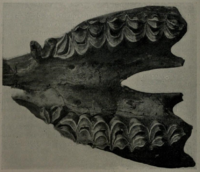Hemiauchenia
|
Hemiauchenia Temporal range: Miocene - , 10–0.010 Ma |
|
|---|---|
 |
|
| Fossil maxilla of Hemiauchenia cf. paradoxa | |
| Scientific classification | |
| Kingdom: | Animalia |
| Phylum: | Chordata |
| Class: | Mammalia |
| Order: | Artiodactyla |
| Family: | Camelidae |
| Tribe: | Lamini |
| Genus: |
†Hemiauchenia Gervais & Ameghino, 1880 |
| Species | |
|
H. macrocephala (Cope, 1893) |
|
H. macrocephala (Cope, 1893)
H. minima (Leidy, 1886)
H. blancoensis (Meade,1945)
H. vera (Matthew, 1909)
H. paradoxa (Gervais & Ameghino, 1880)
Hemiauchenia is a genus of lamine camelids that evolved in North America in the Miocene period approximately 10 million years ago. This genus diversified and moved to South America in the early as part of the Great American Interchange, giving rise to modern lamines. The genus became extinct at the end of the Pleistocene.
Remains of these species have been found in assorted locations around North America including: Florida, Texas, Kansas, Nebraska, Arizona, Mexico, California, Oklahoma, New Mexico, Colorado and Washington. The "large-headed llama", H. macrocephala, was widely distributed in N. and Central America, with H. vera being known from the western U. S. and northern Mexico. H. minima has been found in Florida, and H. guanajuatensis in Mexico.
vera:
• Relatively low-crowned teeth (part of visible teeth ends close to gums)
• Large caniniform upper P1
• Retention of lower P3
blancoensis:
• Shorter mandibular diastema than macrocephala but shorter than vera
• Canniform upper P1
• Absent P2
• Upper P3 present or absent
• Lower crowned molars
macrocephala:
• Long, robust limbs
• Large skeletal size
• Presence of a deciduous upper P2
• Fully molariform deciduous P2
• High-crowned molars
• Thick layer of cementum on the teeth
• Broad mandibular symphasis with incisors in a vertical fashion
minima:
• Despite being the earliest recognized species, general distinguishing characteristics for H. minima are little known.
There are also a few lesser known species such as: H. paradoxa, H. seymourensis, H. edensis and H. guanajuatensis. According to which source is consulted, these may or may not be considered legitimate taxa.
...
Wikipedia
